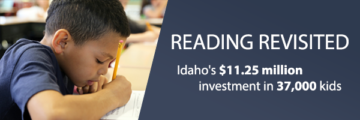While Idaho distributes most of its K-12 dollars based on student population, its literacy dollars are an exception.
The state uses Idaho Reading Indicator test scores to determine where to spend its $11.25 million in literacy money.
 In other words, districts and charter schools with more at-risk readers receive a bigger share of the money. And that means the dollar figures offer some insight into the schools that struggle with low reading scores — and the demographics that coincide with these low scores.
In other words, districts and charter schools with more at-risk readers receive a bigger share of the money. And that means the dollar figures offer some insight into the schools that struggle with low reading scores — and the demographics that coincide with these low scores.
Let’s walk through the math and the demographics, in three steps.
Step One: Tallying the at-risk readers
The state tallies its at-risk reader numbers by looking at three years of results on the IRI, a standardized test given each year in kindergarten through third grade. The state looks at the number of students who scored below grade level on the fall IRI, and then computes a three-year average for each district and charter school.
That’s the source of a number that came up throughout the debate over the 2016 literacy initiative. Based on the past three years of IRI scores, 36,904 K-3 students showed up for school without the skills they need to read at grade level.
From here, the state parceled out its 2016-17 literacy budget, using some simple division. The state took the $11.25 million and divided it against 36,904, that statewide three-year average. That comes out to $304.85 for every at-risk reader.
Districts and charters then received their share based on the three-year averages. For instance, a district or charter with 100 at-risk readers would receive $30,485.
Step Two: Comparing test scores and enrollment
The IRI results only tell us so much. For example, the West Ada School District has 2,976 at-risk readers, the largest number in Idaho — but that stands to reason, since West Ada is by far Idaho’s largest school district.
In order to draw some comparisons between districts and charters, let’s look at those IRI test results in the context of overall enrollment.
For this series, Idaho Education News ran the numbers. We divided the 2016-17 payments against districts’ and charters’ K-3 enrollment for fall 2016.
It is not a perfect model. First, it takes the funding formula for the literacy program and turns it on its head — comparing the dollars against overall enrollment, regardless of student performance. Second, it compares student populations from the past three years to this fall’s headcount. That doesn’t account for 2016-17 enrollment increases, or decreases.
Despite those shortcomings, the model still illustrates which districts and charters have relatively high (or relatively low) numbers of students reading below grade level.
When you divide $11.25 million against 89,808 — this year’s statewide K-3 enrollment — the new magic number drops to $125.27. That’s the per-pupil spending on the literacy initiative, when you consider every K-3 student in Idaho.
Districts and charters that come in above that $125.27 number would tend to have higher concentrations of at-risk readers. Districts and charters that fall below that mark would tend to have lower concentrations of at-risk readers.
A few snapshots from Idaho’s three largest districts: West Ada falls well below the statewide average ($80.68), Boise falls below the average as well ($109.10), while Nampa comes in above the average ($160.18).
Outliers occur on both ends of the spectrum. Chief Tahgee Elementary Academy, a charter school based in Eastern Idaho’s Fort Hall Indian Reservation, is eligible for $239.18 for every K-3 student on its campus. In Meridian, the Compass Public Charter School is eligible for only $37.33 per K-3 student.
Step Three: Demographics matter
For kindergartners, the fall IRI represents their first exposure to a standardized test — just weeks after their first day in the K-12 system. These results are less a reflection on an elementary school than they are a reflection of a young child’s home environment or exposure to preschool.
Demographics matter. That’s the case with test results in general, and certainly the case with the IRI.
* Note: Several high-poverty districts offer free lunch to all students, through a federal rule known as the Community Eligibilty Provision. They are listed in this table at 100 percent FRL eligibility.
Students in poverty. Idaho Education News ran a statistical analysis of the IRI scores against free and reduced-price lunch eligibility, a metric often used to gauge student poverty. The result is a statistically significant correlation; schools with higher poverty rates also have higher concentrations of at-risk readers.
That does not prove a causal link between poverty and low reading scores — but it suggests the two conditions occur simultaneously. And this plays out in high-poverty districts from Wilder and Caldwell to Lapwai and Plummer-Worley.
* LEP numbers are not available for all districts and charter schools. In schools with low LEP student populations, data are redacted to protect student privacy.
English language learners. Students can take IRI practice tests or receive test instructions in Spanish. Ultimately, however, the IRI is designed to measure student proficiency in English, and students must take the test in English.
So, not surprisingly, an Idaho Education News statistical analysis of IRI scores and limited English proficiency student populations yielded a second statistically significant correlation. Districts with higher LEP student populations also tend to have higher concentrations of at-risk readers.
Again, a correlation does not prove a causal link. But in more than a dozen Southern Idaho districts — such as Caldwell, Blaine County, Aberdeen and Wendell — a high LEP population corresponds with a higher rate of students reading below grade level.
Idaho Education News data analyst Randy Schrader contributed to this report.
Literacy series, at a glance
Wednesday: Idaho schools try to bridge a wide reading gap
Wednesday: A close look at literacy dollars, and literacy demographics
Thursday: Literacy initiative tests political patience, and political will
Thursday: As Idaho revamps its literacy program, its reading test awaits a rewrite
Thursday: Rethinking literacy for special education students

